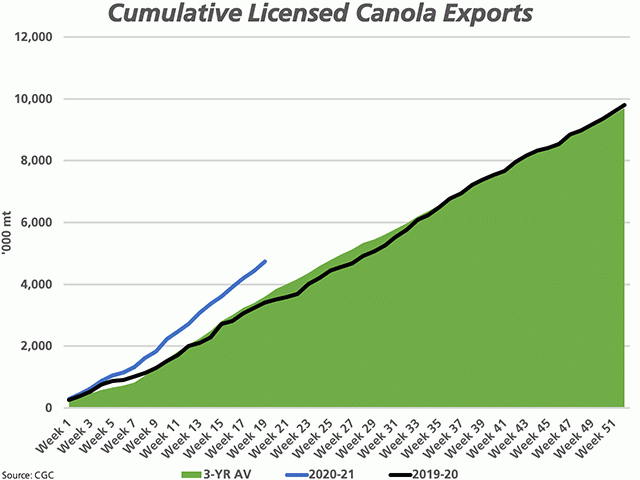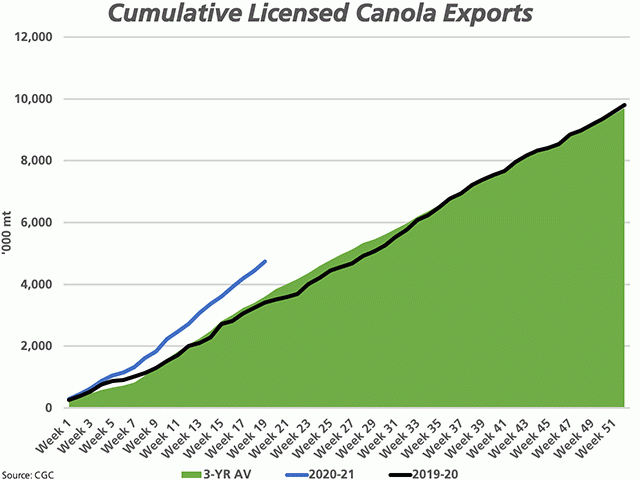Canada Markets
Canola's Export Demand Remains Strong
Various commentary on the canola market over the week mentioned the notion of demand rationing, with current estimates pointing to the possibility of tight stocks at the end of the crop year, or July 31, 2021. Indeed, as is being talked about in the larger soy market, canola stocks could dip to extremely low levels if current government estimates are close to accurate.
This week's Todd's Take column by DTN Lead Analyst Todd Hultman (https://www.dtnpf.com/…), pointed to the need for price to ration demand, with soybean stocks poised to fall to dangerously low levels. Comments made on Thursday's Closing Market Video points to the potential for the close above $12/bushel on the soybean market to lead to a potential quick move to the $13/bushel (bu) level, which is perhaps exactly what we are seeing in Dec. 18 trade.
Given Statistics Canada's final production estimates, supplies of canola for the 2020-21 crop year will be roughly 21.9 million metric tons. The most recent November Agriculture and Agri-Food Canada forecasts, due to be updated this month at any time, includes 10.2 mmt of forecast exports, the same volume achieved in 2019-20 and 10.2 mmt of domestic disappearance, leaving the crop year with a carryout of 1.5 mmt, down 51.6% and the lowest in four years.
Looks good on paper, but the pace of exports through the first 19 weeks remains well-ahead of the forecast pace, as seen on the attached chart. In the latest week 19 data, or the week-ending Dec. 13, 308,600 metric tons were exported through licensed facilities, very close to the largest volume shipped in six weeks and also very close to the third-largest weekly volume shipped in the first 19 weeks or 36.5% of the 2020-21 crop year. For context, only 168,000 mt was needed to be exported this week in order to remain on the steady pace to meet the current government forecast of 10.2 mmt.
Cumulative exports are reported at 4.7996 mmt as of week 19, up 39.8% from the same period in 2019-20 and 33% higher than the three-year average. As seen on the attached chart, the blue line representing the current crop year is taking off on a trajectory of its own. This volume is roughly 1.1 mmt ahead of the steady pace needed to reach the current 10.2 mmt forecast.
P[L1] D[0x0] M[300x250] OOP[F] ADUNIT[] T[]
Favorable prices and weather has supported the flow of grain off the prairies, with producers delivering 541,200 mt in week 19, the largest volume delivered in 10 weeks and 38% higher than the three-year average for this particular week. Commercial stocks fell by a modest 10,000 mt over the week, while at 1.601 mmt, remains 16.4% higher than the three-year average for this week leaving buyers in good shape as we enter the holiday season.
Like soybeans, it is impossible to determine how high futures have to move in order to reduce demand. One chart of interest on ProphetX is a chart showing the price for No. 1 canola C&F China's ports. This price has reached a $521.10 USD high on Friday, which is roughly $666.45/mt based on today's spot Canadian dollar close. This compares to current reports from ICE Canada that shows track Vancouver canola trading at $55/mt over the Jan. close, which equates to $678.80/mt based on the Dec. 18 Jan. futures close of $623.80/mt.
Prairie buyers have kept their powder dry, letting the futures do the work in attracting deliveries, while basis remains weaker than normal across most regions of the Prairies. Pdqinfo.ca's Dec. 17 cash price data for the nine regions of the Prairies shows basis in the Peace Region of Alberta to have a stronger than average basis, calculated at $0.60/mt stronger than the three-year average.
The other eight regions of the Prairies are reported to have weaker than average cash basis, ranging from $1.38/mt weaker in Northern Alberta to $16.04/mt weaker in South East Saskatchewan. Basis across these eight regions averages $11/mt weaker than average.
**
DTN 360 Poll
This week's poll asks if you think your area will benefit from increased biofuel production that is expected to take place as a result of Canada's Clean Fuel Standard that is soon to be released.
This poll can be found on the lower-right side of your DTN Canada Home Page. We thank you for your input!
Cliff Jamieson can be reached at cliff.jamieson@dtn.com
Follow him on Twitter @CliffJamieson
(c) Copyright 2020 DTN, LLC. All rights reserved.






Comments
To comment, please Log In or Join our Community .